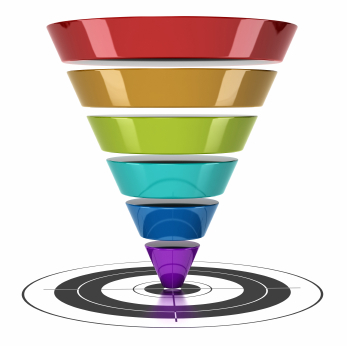Sales is crucial. As I've said before, a business without sales is just a hobby. What are the key steps in building a sales stack?
Companies that employ these three steps will have better results faster than companies who don't. This will be the first in a four part series of posts.Mapping your sales pipeline or funnelThe sales funnel lists the set of states that a lead or prospect goes through on the way to becoming a customer. The words funnel, pipeline, and leaky bucket are all metaphors for visualizing sales as a process of refinement from raw lead, using defined methods called qualifying to yield new paying customers. Not all leads become customers, so the funnel is wide at the top and narrows as leads are qualified. The first step is to determine the stages your leads go through. For example:
Suspect → Prospect → Contacted → Qualified → Demo → Proposal → Closed

There will be a list of leads in each stage of the funnel at any given time. The total number of deals in funnel, the average deal size, the time an average deal stays in the funnel and the number of deals that have advanced from one stage to the next since last week/month are all key funnel metrics. In addition, the % of deals in each funnel stage gives the manager an idea of the health of the overall funnel.One of my favorite books on sales is "Predictable Revenue" by Aaron Ross, who built the sales system for Salesforce.com. Aaron differentiates leads from three different sources or activities he calls: Spears, Nets, and Seeds. Spears describes generating leads from salespeople reaching out to specific targets in a very conscious directed way. This is an expensive method per sale, but perfect for startups looking to determine the identity of their ideal customers. It's also a great technique for companies selling high-ticket goods or services, particularly for key accounts. Nets are marketing activities that generate leads. Examples are internet advertising, content marketing, events, webinars, contests and other campaigns. Nets are great because they are scalable, but until they are informed by the results of spears, nets will often produce leads that are hard (if not impossible) to close. Lower quality leads.Seeds are those planted by delighting your customers. Their referrals are the highest quality leads because they come from unsolicited customer referrals. Your happy customers are the best salesmen of your products or services. The problem of course is that these leads are unpredictable, take a long time to generate and really can't be pushed. They do scale, but in their own time. A combination of all three types of leads will result in the most predictable revenue and growth, so a balanced approach is key.In the next post, we'll talk about the defining criteria for each stage in the funnel and defining the process for moving leads from one stage to the next.